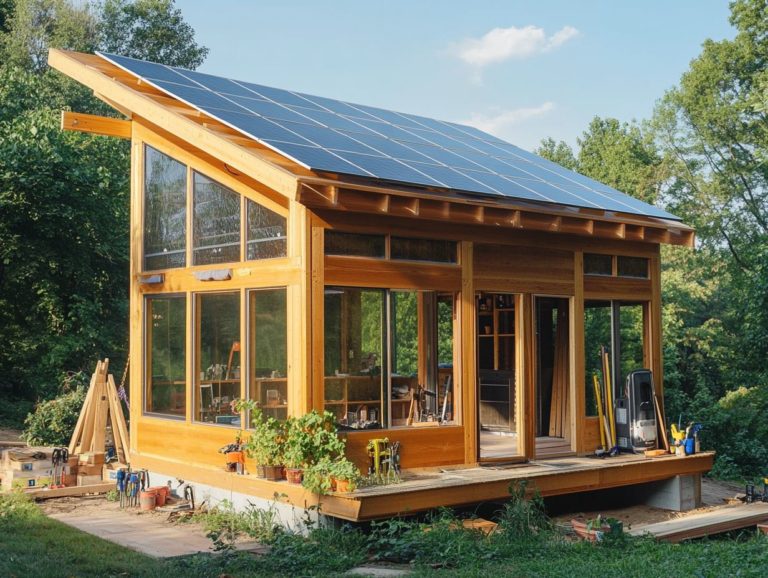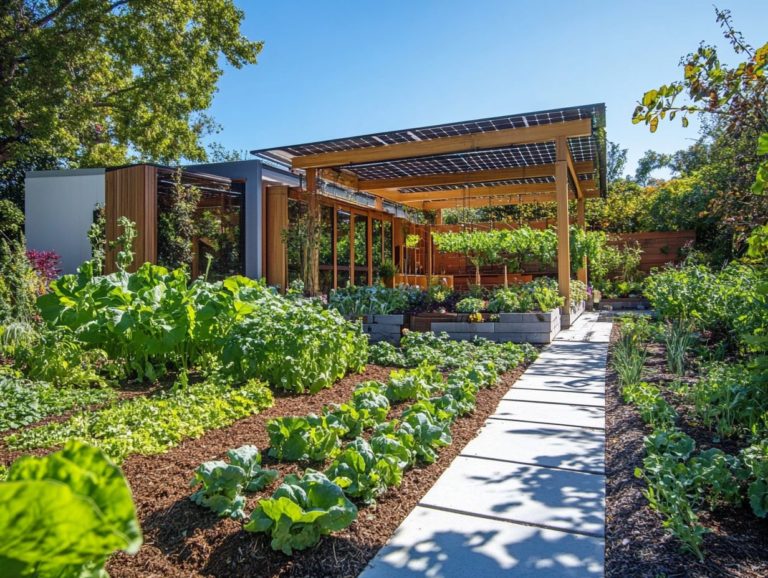DIY Energy-Saving Window Treatments
Energy efficiency is more than just a trend; it stands as a crucial pillar of sustainable living, significant cost savings, and improved home comfort.
A highly effective strategy for enhancing your home s energy efficiency is to upgrade your window treatments. Discover a range of exciting energy-saving options, ranging from insulated curtains to window films and thermal panels, and find insightful DIY installation tips to simplify the process.
You will uncover how these treatments not only help lower your energy costs but also provide additional advantages such as noise reduction, enhanced privacy, and improved insulation value. Elevate your living space while simultaneously saving money and nurturing the environment!
Contents
- Key Takeaways:
- Why Energy Efficiency Matters
- Types of Energy-Saving Window Treatments
- Installation and Maintenance
- Maximize Your Savings on Energy Bills!
- Other Benefits of Energy-Saving Window Treatments
- Frequently Asked Questions
- What are DIY energy-saving window treatments?
- What are some examples of DIY energy-saving window treatments?
- How do DIY energy-saving window treatments help with energy efficiency?
- Can DIY energy-saving window treatments be used in all types of windows?
- Are DIY energy-saving window treatments easy to install?
- How much money can I save by using DIY energy-saving window treatments?
Key Takeaways:

- Investing in energy-efficient window treatments not only benefits the environment but also saves you money on energy bills.
- The three main types of energy-saving window treatments are insulated curtains, window films, and shades/blinds, including honeycomb shades and reflective blinds, each with their own unique benefits.
- Proper installation and regular maintenance, including weatherproofing and addressing humidity issues, are key to maximizing the energy-saving potential of these window treatments.
Why Energy Efficiency Matters
Energy efficiency is essential for reducing overall energy consumption in your home. By embracing energy-efficient practices and materials such as energy-efficient window treatments you can enjoy significant savings on your energy bills while enhancing your living comfort.
The U.S. Department of Energy highlights that adopting these practices can lead to lower heating and cooling costs, all while contributing to a more sustainable environment. Experts like Dan Chiras and organizations such as BuildingGreen stress the importance of integrating energy-efficient designs into your home. Ken Riead of Hathmore Technologies and Peter Yost of BuildingGreen also emphasize the value of implementing these practices for long-term sustainability.
This approach minimizes heat loss and enhances window performance. It also boosts heating, ventilation, and air conditioning (HVAC) performance, providing benefits for both you and the planet.
Types of Energy-Saving Window Treatments
You have a variety of energy-saving window treatments at your disposal, each crafted to enhance insulation and promote energy conservation in your home, catering to your specific needs.
Some of the most sought-after options include insulated curtains, thermal panels, and window quilts. These options excel at minimizing heat loss during the winter while effectively blocking out solar gain in the summer. For more ideas, check out these 10 DIY upgrades for an energy-efficient home.
Cellular shades, reflective blinds, and honeycomb blinds are also popular for their superior light control and resistance to condensation, making them perfect for homeowners who prioritize both energy efficiency and comfort in their living spaces.
Insulated Curtains
Insulated curtains present an exceptional solution for enhancing thermal insulation in your home. They are expertly designed to minimize heat loss during the colder months while also reducing cooling costs in the summer. Their multi-layered fabric construction acts as a vapor barrier, helping to maintain indoor air quality.
These remarkable window treatments feature multiple layers of fabric, often incorporating a thermal lining that effectively creates a barrier against outside temperatures. By blocking drafts with precision, they help you maintain a consistent indoor climate, which can be especially beneficial for households looking to tackle humidity issues and improve overall insulation value through DIY energy-saving home improvements.
Research suggests that insulated curtains can lead to a reduction in energy usage by up to 25% in heating and cooling expenses, translating into significant savings on your utility bills. Beyond fostering comfort within your living spaces, they also enhance overall energy efficiency, making them a wise investment for those who are eco-conscious and committed to sustainability.
Consulting sources like Mother Earth News and experts like William Langdon of Movable Insulation can provide further insights into maximizing these benefits.
Start upgrading your window treatments today and make a positive impact on your comfort and the environment!
Window Films
Window films present an excellent option for homeowners like you who want to boost energy efficiency without diving into extensive renovations. They offer a straightforward and cost-effective way to improve how your windows work, contributing to better overall energy savings.
You ll find these films available in various types, including reflective, tinted, and dual-reflective options. Each type is tailored to address specific concerns such as reducing glare or enhancing privacy. By effectively blocking harmful UV rays the sun’s rays that can cause fading and skin damage and limiting solar heat gain the heat that comes from the sun through your windows these films help create a more comfortable indoor environment. This leads to noticeable energy savings, particularly during those sweltering summer months. Adding exterior storm windows or interior storm panels can further enhance the effectiveness of window films.
Energy audits frequently identify window film application as a strategic recommendation, seamlessly fitting into a comprehensive assessment of your home’s energy performance. This method even helps your cooling systems last longer! It also contributes to lower utility bills, making it a savvy investment for the eco-conscious homeowner. For those looking to enhance their energy efficiency, consider exploring 5 essential tips for DIY energy efficiency projects, as experts like Gary Reysa from Green Home Improvement recommend that window insulation film can further boost the benefits.
Shades and Blinds
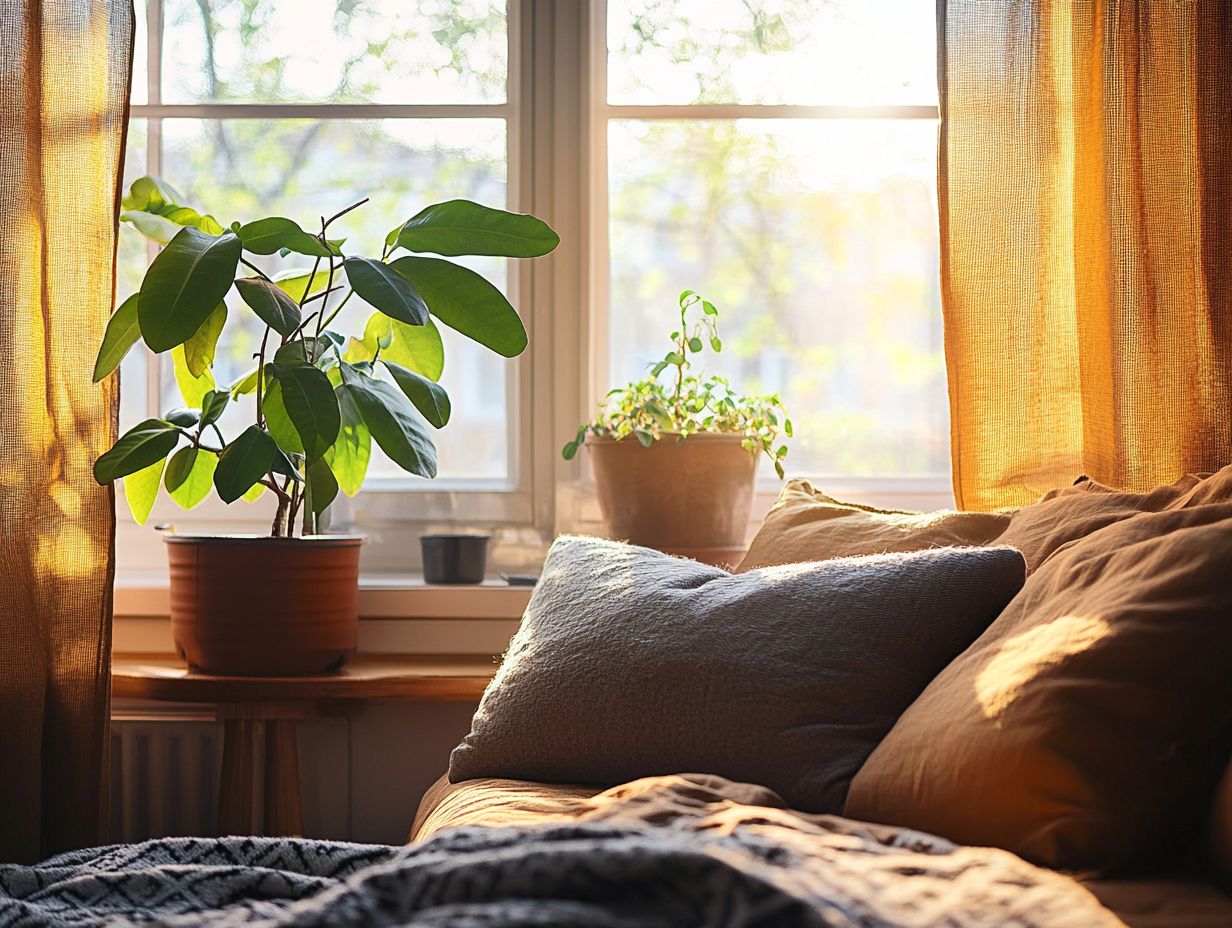
Shades and blinds, including popular choices like honeycomb shades, Roman shades, and energy-efficient curtains, provide you with exceptional light control and aesthetic charm while also enhancing your home’s energy efficiency.
Honeycomb shades, with their innovative cellular structure, not only offer insulation but also trap air effectively. This helps maintain stable indoor temperatures throughout the year.
If you’re looking for a touch of elegance, Roman shades are a fantastic option. They add texture and style while ensuring effective light management.
In contrast to traditional window treatments like sheer curtains or bulky drapes, these modern solutions significantly enhance energy savings by minimizing drafts and reducing your reliance on heating and cooling systems. For more effective strategies, consider these 10 easy DIY home energy efficiency tips.
When incorporating these window coverings into your home improvement plans, consider how these visually appealing options can seamlessly blend with your overall decor while boosting comfort and lowering your utility bills. For added inspiration, explore 5 creative DIY projects to enhance home energy efficiency. Imagine how inviting your home will feel with beautifully installed shades that also cut down on energy costs!
Installation and Maintenance
To truly maximize the effectiveness of your energy-saving window treatments and ensure the longevity of your investment in home energy solutions, proper installation and diligent maintenance are essential.
DIY Steps for Installation
Installing energy-efficient window treatments can be a rewarding DIY project for you. This initiative not only adds a stylish flair to your home but also plays a significant role in reducing energy consumption by helping to regulate indoor temperatures.
To embark on this exciting endeavor, it’s essential for you to gather the necessary tools and materials—think measuring tape, level, drill, and the specific window treatment you’ve chosen, whether it’s shades, blinds, or thermal curtains. For additional guidance, consider checking out DIY insulation hacks for every home. Companies like Spiffy Spools offer a wide range of drapery styles that can meet your DIY needs.
Start by accurately measuring each window to ensure your selected treatments fit snugly. This is crucial for preventing drafts and enhancing overall efficiency. Embrace the DIY spirit it s your opportunity to take a significant step toward creating a more energy-efficient home environment!
Tips for Maintenance and Longevity
Regular maintenance of your energy-efficient window treatments is essential to help you save energy at home.
By establishing a routine cleaning schedule and promptly addressing minor repairs, you’ll enhance the lifespan of your treatments while maximizing their performance. Regular inspections for dust, debris, and signs of wear not only help maintain their aesthetic appeal but also improve how well your home keeps heat in or out, allowing for better temperature regulation.
Simple cleaning methods, like using a soft cloth or a gentle vacuum attachment, can effectively eliminate dirt without causing any damage. It’s also wise to check for fraying or broken components that might hinder functionality and need repairs. This proactive approach helps retain the efficiency and effectiveness of your window treatments.
Maximize Your Savings on Energy Bills!
You need to know the costs and savings of energy-efficient window treatments as a homeowner seeking to make informed decisions that will influence your energy bills and enhance your comfort levels. Consulting sources like Lawrence Berkeley National Laboratory can help you make these informed decisions.
Comparing Costs and Potential Savings
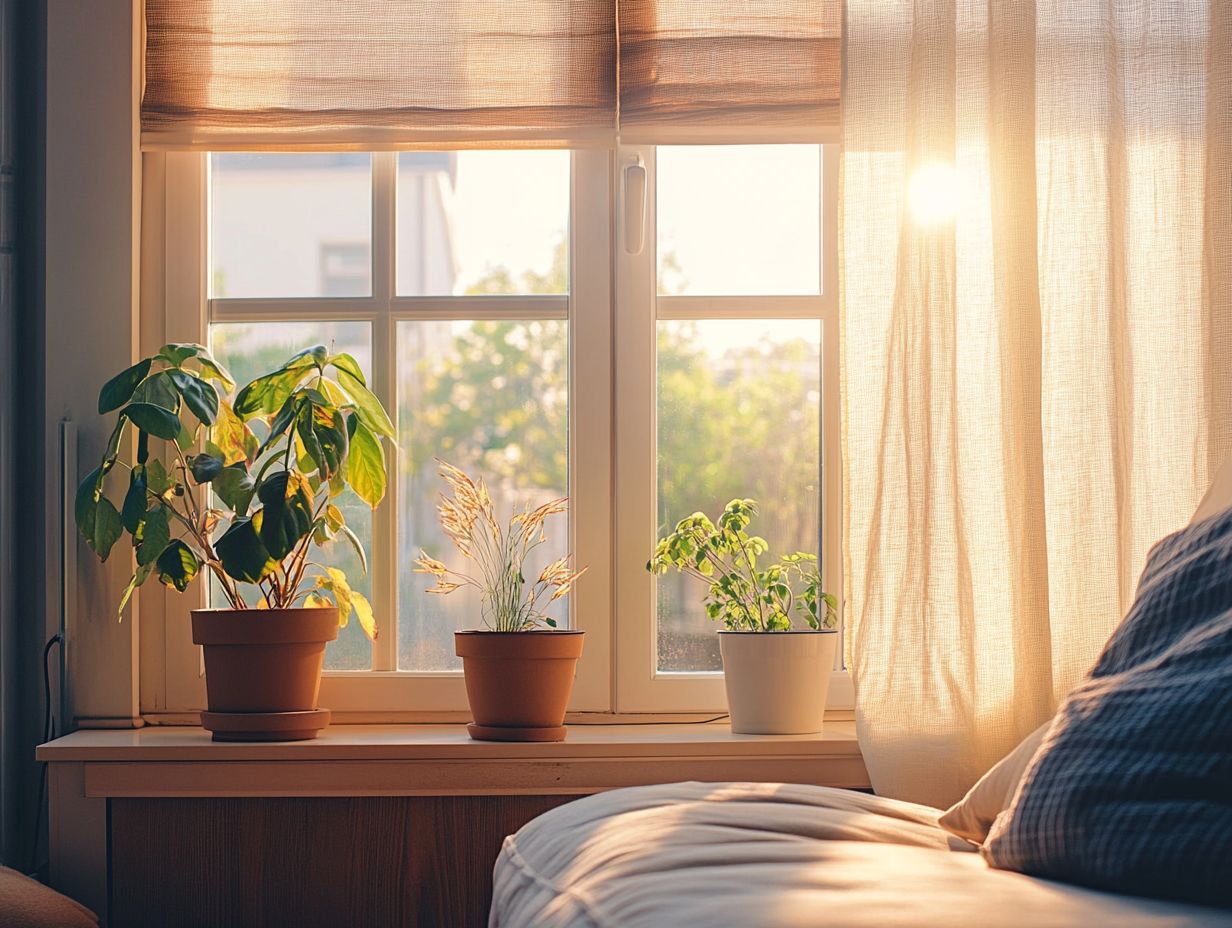
When weighing the costs and potential savings of energy-saving window treatments, it s crucial to consider both the upfront investment and the long-term utility savings. This includes looking into DIY window treatments for a cost-effective approach.
Different types of window treatments, such as cellular shades, blackout curtains, and roller shades, come with varying installation costs and lifespans. For example, cellular shades, with their energy-efficient design, might be a cost-effective choice over time, while blackout curtains could significantly help with temperature control.
Understanding energy savings can help you gauge how quickly you might recuperate your initial investment. To make truly informed decisions, consider conducting an energy audit. An energy audit is a check-up for your home that shows how much energy you use and ways to save it. This can be a valuable tool that allows you to assess your home’s current energy efficiency and pinpoint which window treatments will fit best with your unique needs and financial objectives. Additionally, exploring DIY energy-efficient landscaping ideas can further enhance your home’s sustainability.
Other Benefits of Energy-Saving Window Treatments
Beyond boosting energy efficiency, energy-saving window treatments bring additional advantages that can greatly enhance your home comfort and elevate your lifestyle. Options like awnings and solar screening can also provide significant benefits.
Noise Reduction and Privacy
Energy-saving window treatments enhance your home by reducing external noise and elevating privacy, contributing to your overall comfort and quality of life.
By choosing options like heavy drapes, cellular shades, or soundproof window inserts, you can create a serene living environment that minimizes distractions from the busy world outside. Additionally, implementing 10 simple DIY projects to save energy can enhance your space by absorbing sound and shielding your area from intrusive views, allowing you to enjoy your personal sanctuary without feeling exposed.
When selecting the perfect products, consider essential factors such as material thickness, layering techniques, and customization options to achieve optimal performance. For instance, combining sheer curtains with blackout shades can skillfully deliver both light control and enhanced sound insulation. Additionally, exploring 10 cool DIY projects to reduce energy bills can further enhance your home’s efficiency, striking a beautiful balance between aesthetics and functionality.
Frequently Asked Questions
What are DIY energy-saving window treatments?
DIY energy-saving window treatments are window coverings designed to help reduce energy consumption in a home. These treatments are typically made with materials that provide insulation and can help regulate the temperature inside a room, making it more energy-efficient.
What are some examples of DIY energy-saving window treatments?
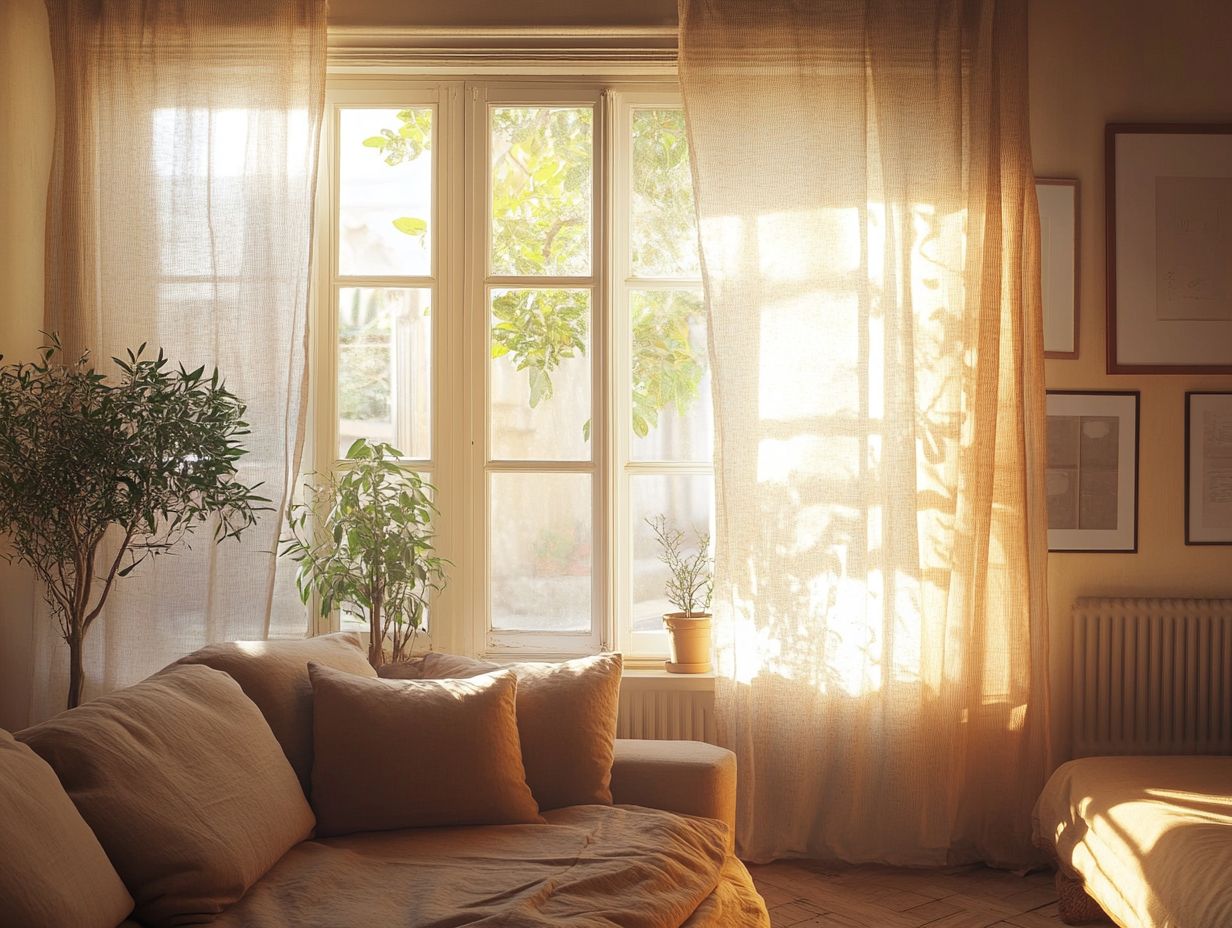
Some great DIY energy-saving window treatments include thermal curtains, window films, weather stripping, and draft stoppers. You can easily make these at home with affordable materials.
How do DIY energy-saving window treatments help with energy efficiency?
DIY energy-saving window treatments add insulation to your windows. They help keep your home warm in winter and cool in summer, cutting down energy costs.
Can DIY energy-saving window treatments be used in all types of windows?
Absolutely! DIY energy-saving window treatments can work in all types of windows, including single and double-hung, casement, and sliding windows. They can also be adapted for various sizes and shapes, making them a versatile and cost-effective option for energy efficiency.
Are DIY energy-saving window treatments easy to install?
Most DIY energy-saving window treatments are easy to install and require minimal tools. Many come with straightforward instructions and can be completed within a few hours. If you re unsure about DIY installation, it s best to consult a professional to ensure a perfect fit.
How much money can I save by using DIY energy-saving window treatments?
Act now, and you could save up to 30% on your energy bills! The savings will depend on factors like the size and type of windows, the materials used, and your climate. However, many homeowners enjoy significant reductions in their energy costs by using these treatments.

